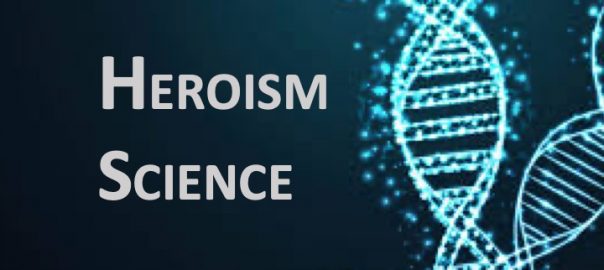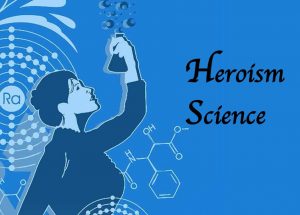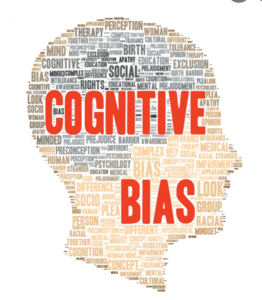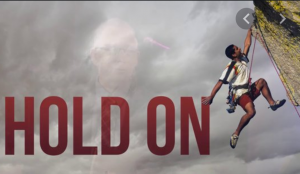 Below is a partial listing of heroism-related phenomena discovered by Dr. Scott T. Allison’s research lab from 2005 to the present day.
Below is a partial listing of heroism-related phenomena discovered by Dr. Scott T. Allison’s research lab from 2005 to the present day.
1. The Death Positivity Bias – 2005
The tendency of people to evaluate the dead more favorably than the living. This is one way we “heroize” people.
Allison, S. T., & Eylon, D. (2005). The demise of leadership: Death positivity biases in posthumous impressions of leaders. In D. Messick & R. Kramer (Eds.), The Psychology of Leadership: New Perspectives and Research (pp 295-317). New York: Erlbaum.
2. The Frozen in Time Effect – 2005
People’s tendency to resist changing their impressions of dead heroes compared to living heroes.
Eylon, D., & Allison, S. T. (2005). The frozen in time effect in evaluations of the dead. Personality and Social Psychology Bulletin, 31, 1708-1717.
3. The Underdog Abandonment Effect – 2008
The tendency of people to no longer root for underdog heroes when both their success has low self-relevance and low consequences.
Kim, J., Allison, S. T., Eylon, D., Goethals, G., Markus, M., McGuire, H., & Hindle, S. (2008). Rooting for (and then Abandoning) the Underdog. Journal of Applied Social Psychology, 38, 2550-2573.
4. The Great Eight Traits of Heroes – 2011
The discovery that people believe that heroes possess the traits of wise, strong, charismatic, caring, resilient, reliable, selfless, and inspiring.
Allison, S. T., & Goethals, G. R. (2011). Heroes: What they do and why we need them. New York: Oxford University Press.
5. Social Influence Based Taxonomy of Heroism – 2012
The scientific identification of heroes as Transforming, Transfigured, Traditional, Transparent, Transposed, Tragic, Transitional, Transitory, Trending, and Transcendent.
Allison, S. T., & Goethals, G. R. (2013). Heroic leadership: An influence taxonomy of 100 exceptional individuals. New York: Routledge.
6. The Heroic Leadership Dynamic – 2014
A system of psychological forces that can explain how humans are drawn to heroes, how they benefit from these heroes and their stories, and how heroic tales help people become heroes themselves.
Allison, S. T., & Goethals, G. R. (2014). “Now he belongs to the ages”: The heroic leadership dynamic and deep narratives of greatness. In Goethals, G. R., et al. (Eds.), Conceptions of leadership: Enduring ideas and emerging insights. New York: Palgrave Macmillan.
7. Epistemic and Energizing Functions of Heroism – 2014
The conceptualization of the functions of heroism that includes epistemological needs involving the imparting of wisdom and emerging needs involving healing, growing, and inspiration.
Allison, S. T., & Goethals, G. R. (2014). “Now he belongs to the ages”: The heroic leadership dynamic and deep narratives of greatness. In Goethals, G. R., et al. (Eds.), Conceptions of leadership: Enduring ideas and emerging insights. New York: Palgrave Macmillan.
8. The Johnny Carson Effect – 2014
The tendency of people’s current need states to determine their choice of heroes, with these need-states changing as a function of people’s developmental stages and their changing life circumstances. (named after Johnny Carson’s quip that after all his divorces, his hero changed from Babe Ruth to King Henry VIII)
Allison, S. T., & Goethals, G. R. (2016). Hero worship: The elevation of the human spirit. Journal for the Theory of Social Behaviour, 46, 187-210.
9. Six Benefits of Suffering – 2016
The identification of benefits of heroic suffering as offering (1) redemption, (2) developmental progress, (3) humility, (4) compassion, (5) social union, and (6) meaning and purpose.
Allison, S. T., & Setterberg, G. C. (2016). Suffering and sacrifice: Individual and collective benefits, and implications for leadership. In S. T. Allison, C. T. Kocher, & G. R. Goethals (Eds), Frontiers in spiritual leadership: Discovering the better angels of our nature. New York: Palgrave Macmillan.
10. Six Types of Heroic Transformation – 2017
Six commons patterns of transformation in heroes that involve changes in their mental, emotional, physical, spiritual, moral, and motivational state.
Allison, S. T., Goethals, G. R., & Kramer, R. M. (2017). Setting the scene: The rise and coalescence of heroism science. In S. T. Allison, G. R. Goethals, & R. M. Kramer (Eds.), Handbook of heroism and heroic leadership. New York: Routledge.
11. Three Heroic Transformative Arcs – 2017
The tendency of heroes to transform from a state of egocentricity to sociocentricity; from dependence to autonomy; and from stagnation to growth.
Allison, S. T., & Goethals, G. R. (2017). The hero’s transformation. In S. T. Allison, G. R. Goethals, & R. M. Kramer (Eds.), Handbook of heroism and heroic leadership. New York: Routledge.
12. The Personal Heroic Imperative – 2018
Each human being’s built-in mandate to fulfill their heroic imperative by imagining and creating their own heroic growth.
Efthimiou, O., Allison, S. T., & Franco, Z. E. (2018). Heroism and wellbeing in the 21st century: Recognizing our personal heroic imperative. In O. Efthimiou, S. T. Allison, & Z. E. Franco (Eds.), Heroism and wellbeing in the 21st Century: Applied and emerging perspectives. New York: Routledge.
13. Transcendent and Trapped Immortality – 2018
The tendency of people to perceive dead heroes and villains differently. Specifically, we believe deceased good-doers achieve transcendent immortality, with their souls persisting beyond space and time; and evil-doers to have trapped immortality, with their souls persisting on Earth, bound to a physical location.
Gray, K., Anderson, S., Doyle, C. M., Hester, N., Schmitt, P., Vonasch, A., Allison, S. T., and Jackson, J. C. (2018). To be immortal, do good or evil. Personality and Social Psychology Bulletin, 44, 868-880.
14. Heroic Lag – 2019
The delay between the point in time when a hero first expresses their heroic message and when mainstream society adopts that message.
Goethals, G. R., & Allison, S. T. (2019). The romance of heroism and heroic leadership: Ambiguity, attribution, and apotheosis. West Yorkshire: Emerald.
15. Heroic Consciousness – 2019
The tendency of heroes to demonstrate a mental and experiential approach to the world that is nondualistic, transrational, unitive, and empowered.
Allison, S. T. (2019). Heroic consciousness. Heroism Science, 4, 1-43.
16. Seven Barriers to Heroic Transformation – 2019
The tendency of people to avoid heroic transformation because of self-ignorance, impoverished environments, personal trauma, victim identification, absence of mentors, mental/physical illness, and lack of psychological flexibility.
Allison, S. T., Goethals, G. R., Marrinan, A. R., Parker, O. M., Spyrou, S. P., Stein, M. (2019). The metamorphosis of the hero: Principles, processes, and purpose. Frontiers in Psychology, 10, 606.
17. Heroic Leadership Imperative – 2020
The mandate of transforming heroic leaders to meet the individual, collective, and transcendent needs of their followers.
Allison, S. T. & Goethals, G. R. (2020). The heroic leadership imperative: How leaders inspire and mobilize change. West Yorkshire: Emerald.
18. Heroic Wholeness Imperative – 2020
The mandate of leaders to promote psychological wholeness and well-being by meeting the higher-level transcendent needs of followers.
Allison, S. T. & Goethals, G. R. (2020). The heroic leadership imperative: How leaders inspire and mobilize change. West Yorkshire: Emerald.
19. The Hero Androgyny Phenomenon — 2020
The tendency of heroes to possess both masculine and feminine traits, i.e., agency plus communality.
Hoyt, C. L., Allison, S. T., Barnowski, A., & Sultan, A. (2020). Lay theories of heroism and leadership: The role of gender, communion, and agency. Social Psychology, 51, 381-395.
20. Puer Aeternus as an Obstacle to Heroism
Allison, S. T., Goethals, G. R., & Spyrou, S. P. (2020). Donald Trump as the archetypal puer aeternus: The psychology of mature and immature leadership. In K. Bezio & G. R. Goethals (Eds.), Leadership, populism, and resistance. Northampton, MA: Edward Elgar.
21. Heroic Autonomy — 2021
The imperative of the hero to perform the last and most crucial heroic act alone and independent from their friends and mentors.
Allison, S. T. (2021). Beth Harmon’s hero’s journey: The psychology of heroism in The Queen’s Gambit. Richmond: Palsgrove.
22. Heroic Balance — 2021
The ability of the hero to achieve a healthy life balance needed to achieve their heroic mission. Heroes needs to balance intuition with reason; emotion with logic; self-confidence with humility; autonomy with dependency; personal life with professional life; and more.
Allison, S. T. (2021). Beth Harmon’s hero’s journey: The psychology of heroism in The Queen’s Gambit. Richmond: Palsgrove.
23. Dynamic Negotiated Exchange Theory of Heroism –2022
Allison, S. T., & Beggan, J. K. (2022). The dynamic negotiated exchange model of heroism and heroic leadership: Lessons from the COVID-19 pandemic. Interdisciplinary Journal of Leadership Studies, 1, 15-31.
24. Motional Intelligence — 2023
A form of kinesthetic intelligence that enables leaders to move the emotions of their followers. It is the ability of heroic (and villainous) leaders to use their body movements and voices effectively in a way that inspires and mobilizes followers.
Allison, S. T. (2023). Motional intelligence and leadership. In G. R. Goethals, S. T. Allison, & G. J. Sorenson (Eds.). The SAGE Encyclopedia of Leadership Studies. Sage: Thousand Oaks, CA.
25. Hero Illiteracy — 2023
The tendency of people to confuse fame for heroism, such that they attribute heroism to celebrities who are famous for non-heroic reasons.
Allison, S. T. (2023). Heroism attribution error. In S. T. Allison, J. K. Beggan, and G. R. Goethals (Eds.), Encyclopedia of Heroism Studies. New York: Springer.
27. Intuitive Heroism — 2024
Intuitive heroism refers to how individuals naturally and intuitively make sense of heroism. People have their own ideas about what heroes do, what heroes are like, and what motivates heroism. These intuitive notions of heroism are accurate in some ways but also contain factual errors and misunderstandings about heroism.
Allison, S. T. (2024). Intuitive heroism. In S. T. Allison, J. K. Beggan, and G. R. Goethals (Eds.), Encyclopedia of Heroism Studies. New York: Springer.
28. Perfect Confluence and Heroism — 2024
The “perfect storm” is a term often used metaphorically to describe situations where a convergence of multiple factors leads to a particularly significant or catastrophic outcome. The perfect confluence refers to any convergence of circumstances that results in a particularly positive or heroic outcome.
Allison, S. T. (2024). Perfect storm, perfect confluence, and heroism. In S. T. Allison, J. K. Beggan, and G. R. Goethals (Eds.), Encyclopedia of Heroism Studies. New York: Springer.
29. Heroism-by-Proxy — 2024
Heroism-by-proxy describes a psychological phenomenon that occurs when an individual develops a strong psychological association with a hero or a heroic figure, leading to a sense of personal heroism. Heroism-by-proxy can be constructive when it inspires heroism but can be destructive when it engenders either complacency or a psychological identification with violent, divisive leaders.
Allison, S. T., Beggan, J. K., & Goethals, G. R. (2024). Heroism-by-Proxy. In S. T. Allison, J. K. Beggan, and G. R. Goethals (Eds.), Encyclopedia of Heroism Studies. New York: Springer.
30. Amalgamated Heroes — 2024
An amalgamated hero is a legendary, cultural hero who is derived from a complex blending of similar historical figures and our own cognitive embellishments of those figures.
Allison, S. T. & Hutchins, R. (2024). Amalgamated heroes. In S. T. Allison, J. K. Beggan, and G. R. Goethals (Eds.), Encyclopedia of Heroism Studies. New York: Springer.









